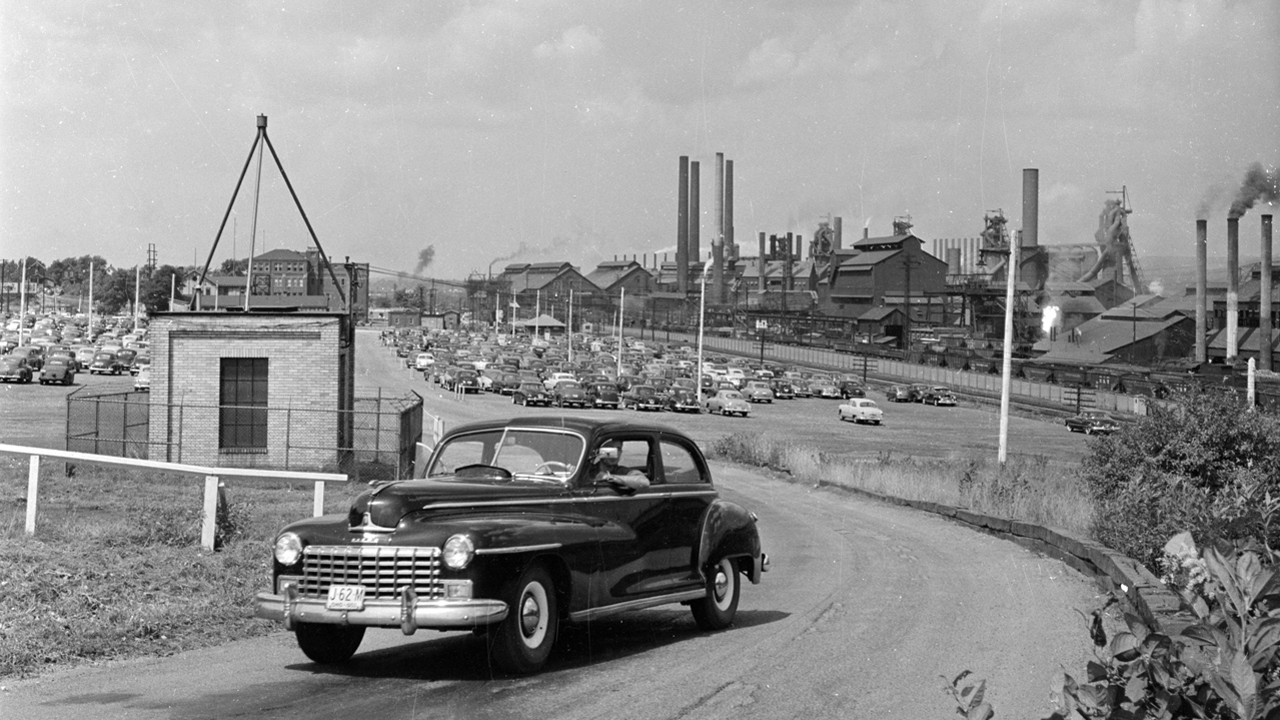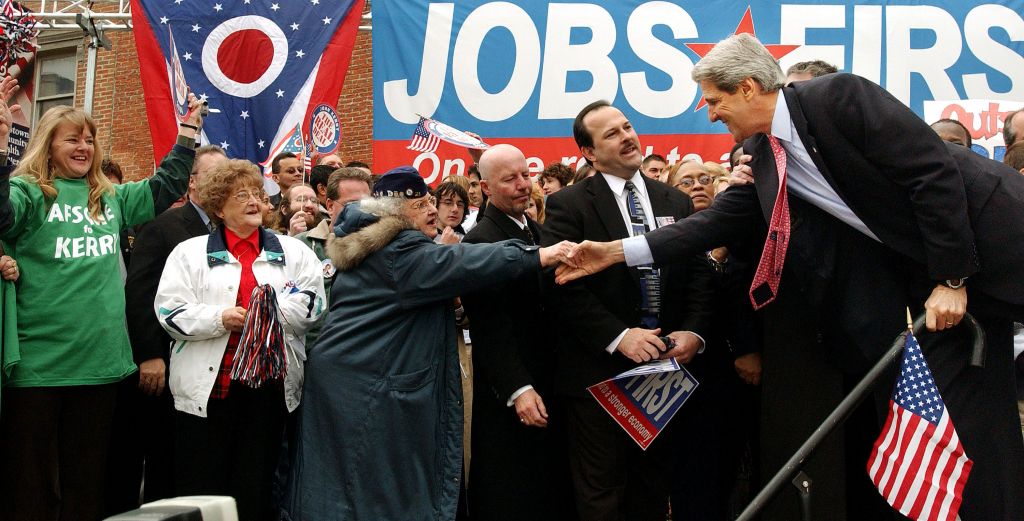
The caption of this 1950 photo says it depicts American steelworker Charlie Grapentine as he drives his Dodge home from work. He earns $320 per month at the United States Steel Corporation in Youngstown, Ohio. His salary supports his wife and their two children. US Steel closed the facility in 1980. (Photo: Doreen Spooner/Keystone Features/Getty Images)
EDITOR’S NOTE: As many experts have observed, this year’s presidential election could come down to a battle for votes Democrats used to take for granted.
Donald Trump is making an overt play for the so-called “Reagan Democrats,” blue collar voters whose defection three decades ago shook up the national political landscape and stoked the Reagan revolution. It’s no accident that Hillary Clinton’s first post-convention foray was into once reliably Democratic steel and coal country. Now, as then, the issues facing these voters are job and income security in a changing world. Only now, those concerns are being felt by far more than the steelworkers and their families whom Ronald Reagan wooed in 1980.
America’s deindustrialized heartland embodies one of the challenges reshaping the nation’s politics: The disappearance of the middle class and the growing gap between the haves and have-nots. That’s why BillMoyers.com is paying particular attention to these communities this year, focusing on their issues and giving voice to the people who live there. You can read more of our collection here.)
Once again, struggling Youngstown, Ohio and other Rust Belt communities like it are in the political spotlight. Like clockwork, once every four years, the candidates for the nation’s highest office descend on cities like this one to commiserate with its residents over what has happened to the American manufacturing economy and the millions of middle-class livelihoods it made possible.
How Youngstown Plans to Overcome Decades of Decline
“The politicians always come, because Ohio is a swing state, but nothing ever changes,” says Sean Posey, a local community college professor and author of the new book Lost Youngstown. “In fact, it gets worse.”
On a recent visit to the once-bustling steel town, however, local residents told us they’re no longer waiting for a new president or a big new employer to help their town.
In the video report above, co-produced with the NewsHour Weekend as part of the series, “Poverty and Opportunity: Chasing the American Dream,” producer Karla Murthy found a kind of DIY recovery effort underway.
She talked to Youngstown residents who, with the help of the Youngstown Neighborhood Development Corporation, are trying to rebuild their town, one blighted home at a time.
The Youngstown residents are hoping that a more attractive community will help attract jobs, long the missing ingredient in the city’s recovery.
In 1980, when Ronald Reagan made a celebrated visit to woo the local union Democrats, the layoffs that would decimate the local steel industry had just begun a few years before, but the mills were since running. By the time then-Democratic presidential candidate John Kerry visited in 2004, he had abandoned factories for a backdrop.

Democratic presidential candidate Sen. John Kerry (D-MA) shakes hands with a supporter during a 2004 rally in Youngstown, Ohio. (Photo by Stephen Chernin/Getty Images)
Since the late 1970s, Youngstown has lost 40,000 manufacturing jobs and the tax revenues that went with them. The city’s population, which the US Census calculated at just north of 65,000 in 2014, is half of what it was in the 1930s, when Youngstown was part of the proudly gritty Ohio Valley steelmaking complex — the smithy on which the armaments that won World War II were forged. Of the people who remain in Youngstown today, 41 percent live in poverty — more than double the national average.
President Barack Obama visited in 2010 to hail one of the few bright spots on the Mahoning Valley landscape: a new specialty steel mill. Since then, however, a drop in oil prices has led to a drop in demand for the mill’s pipes, used in fracking, and the plant has had several rounds of layoffs. “It’s a tenuous existence,” Paul Sracic, a political science professor at Youngstown State University, said when asked to describe the mood in town.
Perhaps because of that, the area still retains its symbolic appeal to politicians: During last month’s Ohio primary campaign, Youngstown played host to Bernie Sanders, Hillary Clinton and Donald Trump all dutifully trooped there this year, along with, of course, Ohio Gov. John Kasich, another contender for the Republican nomination.
Across the Rust Belt the story repeats over and over again: One-time auto boomtown Flint, Michigan, now the home to an infamous water crisis. As in Youngstown, more than 40 percent of the population there lives in poverty. In depopulated Braddock, Pennsylvania, which has lost 90 percent of its population, Mayor John Fetterman is campaigning for Senate on the strength of his Sisyphean effort to revive the town that was home to Andrew Carnegie’s first steel mill.
Braddock’s poverty rate is 36 percent and the median value of a home is one-fifth of what it is in the rest of the state. In Reading, Pennsylvania, the decision by the corporate progeny of Western Electric to move to Taiwan quashed the Silicon Valley of its day and the town is now the setting for a highly acclaimed play about the toll outsourcing takes on a community. Reading’s poverty rate: Almost 39 percent.
Since the late 1970s, the number of Americans working in manufacturing has dropped by half, according to data provided by the Bureau of Labor Statistics. And while the highest concentration of the nation’s most distressed zip codes remains in the South, the shuttering of factories has created pockets of grinding poverty in places that no longer have the political clout to cope with it.
Across the nation’s one-time industrial heartland, “many cities have lost one-third of their population or more,” says Michael Goff of the Northeast-Midwest Institute. “That affects everything.” It’s one reason unemployment numbers can’t fully describe the extent of the losses. Another figure which comes closer: Thirty years ago, Goff says, the 18 states represented by his institute boasted half the members of Congress. Today, their representatives make up just one-third of the nation’s legislature.
At Moyers & Company, we have decided to make communities like these a focus of our political coverage in 2016. We want to know why the residents of America’s Youngstowns have been failed by the politicians who quadrennially come calling for their votes. Understanding this seems fundamental to understanding the anger fueling so much of this year’s politics (Donald Trump won the Republican vote in Ohio’s Mahoning County, where Youngstown is located). If these communities are where some of the problems plaguing our body politic began, they seem to be the places we should begin seeking solutions.
Have a facet of this story you’d like to see us explore? A community you’d like us to feature? Write to us via email or in the comments below. Let the conversation begin.




